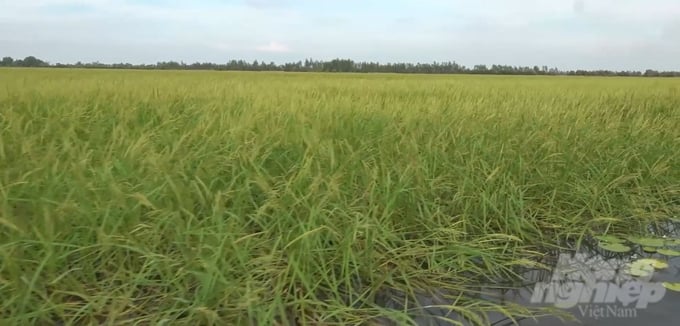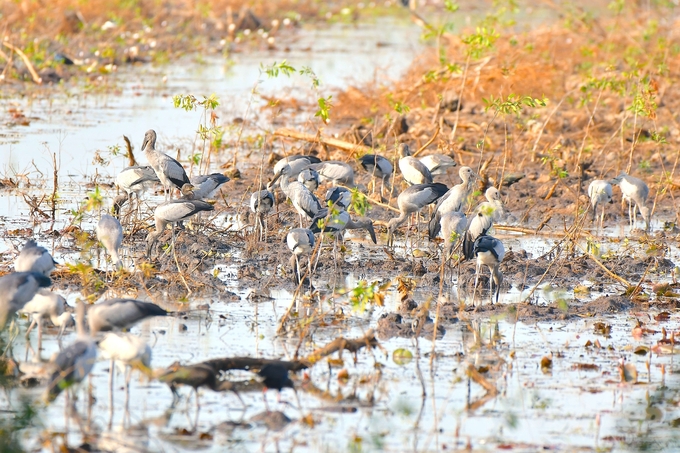November 11, 2025 | 10:26 GMT +7
November 11, 2025 | 10:26 GMT +7
Hotline: 0913.378.918
November 11, 2025 | 10:26 GMT +7
Hotline: 0913.378.918
People in Long An province are participating in three main models to improve their livelihoods, which are the rice-fish model, the water hyacinth weaving model, and the model of floating rice growing using the Nang Tay Dum variety.
In particular, the floating rice growing model deployed by the World Wide Fund for Nature in Vietnam (WWF-Vietnam) in Vinh Dai and Vinh Chau A communes, Tan Hung district (Long An), has initially shown signs of economic efficiency and biodiversity conservation.

The model of floating rice growing using the Nang Tay Dum variety brings to farmers a profit of 10–12 million VND/ha. Photo: VAN.
Regarding economic efficiency, farmers participating in this livelihood model will have income from rice growing and fishing activities in rice fields. According to the Vinh Dai Commune People's Committee, in recent years, the average rice yield reached 1 ton/ha, reducing significantly compared to before due to the influence of weather. However, with the current purchasing price of 15,000 VND/kg, farmers still earn a profit of 10–12 million VND/ha. Farmers also earn an additional income of 3-5 million VND/ha from fish.
Regarding biodiversity conservation, Mr. Huynh Quoc Tinh, representative of WWF-Vietnam, said: "The floating rice model we deployed in the buffer zone of Lang Sen Wetland Reserve initially had quite good and positive environmental records."
According to Mr. Huynh Quoc Tinh, the amount of alluvium deposited in this floating rice model is 3 times higher than the 3-crop rice farming model, while the amount of water stored for reimbursement is nearly 20 times higher. Besides, the number of aquatic and fish species is also higher than in 3-crop rice growing areas as well as other areas.

The amount of alluvium deposited in this floating rice model is 3 times higher than the 3-crop rice farming model. Photo: VAN.
In addition to the livelihood model of restoring floating rice for people in the buffer zone, among the projects that WWF-Vietnam implemented in this land are also many other projects bringing sustainable livelihoods. Since implementing these projects, the lives of people in this buffer zone have changed positively.
Sharing with Vietnam Agriculture Newspaper, Assoc. Prof. Dr. Nguyen Phu Son said that sustainable livelihood includes up to five types of assets: human, natural, financial, social, and physical. Since WWF-Vietnam implemented projects to bring livelihoods for people in the buffer zone, there are two types of assets that have shown positive signs, which are human assets and social assets.
"The reason I say that is only when WWF's projects as well as other projects and programs participated in this area did people here begin to participate in activities and forms of business or diversify their income through many different occupations," said Assoc. Prof. Dr. Nguyen Phu Son.

Activities to improve livelihoods for people in the buffer zone that Lang Sen Wetland contributed to protecting the plant and animal ecosystem here. Photo: Hoang Vu.
Despite initial efficiency, in order to more effectively implement the projects to improve the lives of people in the buffer zone of Lang Sen Wetland Reserve in the coming time, it requires the participation of the whole community, including the Reserve Management Board as well as the local government of Tan Hung district, Long An province. As an organization with a project continued for the following years, WWF-Vietnam made some recommendations.
Representative of WWF-Vietnam Huynh Quoc Tinh said that the project's orientation is to help the community have more sustainable choices and accelerate progress during the flood season. Within the framework of the project, WWF-Vietnam wishes to build capacity for the community and locality there and for the national park management board. After the project ends, it is recommended to have a mechanism for the model to continue to be maintained.
Besides, the representative of WWF-Vietnam also hopes that the locality will coordinate with projects and businesses to disseminate and raise people's awareness about the benefits and balance between short-term and long-term benefits in preserving biodiversity and their livelihoods.
"We also wish the local government to support projects and programs that the State is supporting investment, because through those programs and projects, people can receive additional support in terms of capacity, techniques, or technology to be able to enhance the product value. Combined with the story built on this Lang Sen Wetland Reserve, I hope that the added value of the product will be better and meet people's livelihoods while still preserving the value of this wetland," said Mr. Huynh Quoc Tinh.
In recent times, activities to improve livelihoods for people in the buffer zone that Lang Sen Wetland Reserve coordinates with international organizations, typically WWF-Vietnam, have contributed to limiting people's illegal entry to catch aquatic products and wild animals, thereby protecting biodiversity for the plant and animal ecosystem here.
Translated by Thu Huyen

(VAN) Marine resources beneath the sea are being gradually identified and studied, forming the foundation for sustainable exploitation and the development of a blue economy.

(VAN) Residents in the Lang Sen buffer zone can improve their income and preserve wetland biodiversity thanks to the nature-based livelihood models.

(VAN) The Department of Hydraulic Works Management and Construction aims to build a modern, smart, and sustainable water management sector that ensures water security and promotes rural development in Viet Nam.

(VAN) Dong Thap province stands before major opportunities in restructuring its economy, particularly in agriculture and environmental management, which have long been local strengths.

(VAN) The degradation of Cat Ba’s coral reefs is not a random phenomenon but the result of a series of negative factors that intertwine human activities with harsh natural changes.

(VAN) A synchronized scientific strategy combined with stringent management is considered the dual solution to protect the precious swiftlet population and affirm the nation's brand position.

(VAN) The renewal of agricultural extension work based on the green agricultural economy mindset is an essential requirement, contributing to the intellectualization of farmers, promoting green production, and achieving sustainable development.